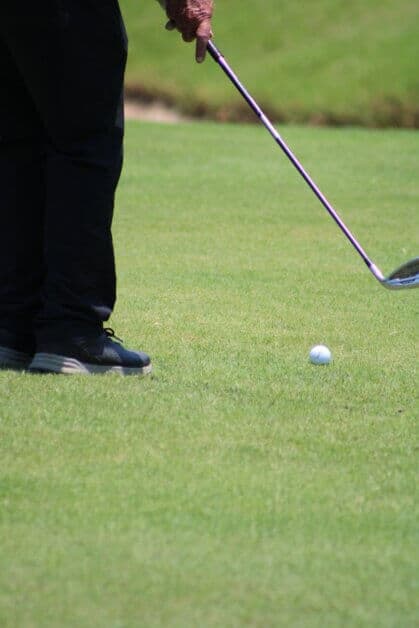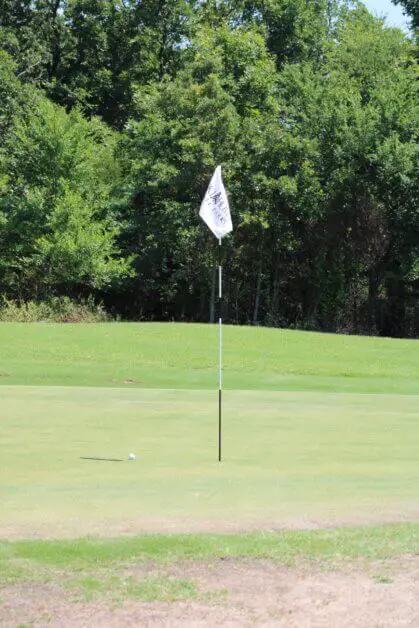One of the things that anyone who’s into golf knows is that this sport is full of unique terms. For example, if you’re a beginner and you’re buying a new golf club, you’ll find a plethora of recommendations and key aspects to keep in mind while picking the ideal club for your needs.
However, no matter what golf club you’re buying, one of the most recurring themes in recommendations while picking a club is how essential it is for the club to be forgiving.
So what does forgiveness mean in golf? And how do you achieve it?
In today’s article, we’ll take a deep dive into the concept of forgiveness in golf to give you a better idea of its origin and why it is such a popular term. So without further ado, let’s dive right in!
What Does Forgiveness Mean In Golf?
There are three primary factors that golfers use to evaluate the quality of any golf club that they use, which are:
- Forgiveness
- “Feel”
- Distance or accuracy, depending on the type of the club
While distance, accuracy, or feel can vary in significance from one golf club to the other, forgiveness is always an essential and crucial factor that plays a significant role in the choice making process. This makes it, for a lot of players, the most critical aspect of the triad.
While there’s no established term for forgiveness in golf, a lot of golfers are capable of explaining it.
This term is simply used to refer to a design and construction aspect of the golf club, which describes the level of responsiveness and correction that the golf makes to reduce the impact of a poor club swing or hitting the ball outside of the “sweet spot”.
For instance, if you hit the ball using the dead center of the club face, the ball will take off at the highest distance possible, traveling in a straight line, which ensures that the ball lands exactly where you want it to go.
However, the further you miss that dead center, the more likely for the ball to travel at a slower speed with a chance of landing further from what you expect it to.
How Can Forgiveness in a Golf Club Help Players?
Forgiveness in golf clubs is there to help these players to improve the shot by increasing the size of that “sweet spot” on the clubhead, which gives you a higher chance of landing the perfect hit.
Golf clubs that are designed with elements that improve forgiveness are known as “game improvement clubs”.
Although all golfers, including world-class elite, are always looking for a golf club with a decent level of forgiveness and game improvement element, players with a higher handicap should put forgiveness ahead of any other aspect while picking a beginner-friendly golf club.
When Did the Concept of Forgiveness in Golf Clubs Emerge?
Back in the day when golf clubs were first mass produced, almost all golf clubs, especially the irons, were built the same way.
All these golf clubs had characteristically thin clubfaces with the vast majority of the weight in the iron clubs concentrated behind the center of the clubface.
Since this mass is mainly responsible for generating speed and achieving distance upon impact, it was considered the sweet spot of the golf club. In other words, if you want to generate the best shot, you need to be hitting the ball exactly at the center of the clubface.
The problem with that design is that all the “pure shot” chances are concentrated exactly at one spot on the club.
So, if you miss this tiny magic spot for any reason, you’ll get a relatively inferior shot. As soon as you miss-hit a ball off the tee, you’ll also feel it in your hands.
This continued to be a problem up until the 60s of the last century when Karsten Solheim, an engineer in General Electric, took golf as a hobby.
Despite playing golf for the first time at 42 years old, he quickly noticed the problem with golf clubs and became dissatisfied with the poor quality of available golf clubs at the time.
To solve this problem, Solheim implemented several scientific and design corrections to help improve the distribution of weight behind the clubface of the golf iron. He then started building this improved golf club in his garage by adding some extra weight around the edges.
This design correction is called “perimeter weighting”, and it’s one of the foundations of a more forgiving golf club that we’re going to discuss in the following sections.
This perimeter weighting helped in creating a significantly larger sweet spot which helped in improving Solheim’s game greatly!
In fact, the golf club was such a huge success that he founded a company that sells these golf clubs under the name “PING Clubs”, which refers to the “ping” sound that the golf club makes when you hit the golf ball exactly at the sweet spot.
The company was popular back then for the forgiveness of their clubs for the average golfer who isn’t able to consistently hit the ball at the sweet spot.
What Is the Design Element That Improves Forgiveness in a Golf Club?
Since the concept of a forgiving golf club became a huge success among golfers, more companies tried to keep up by hiring researchers and engineers who can create even more forgiving golf clubs.
Today, there are several design elements that can improve forgiveness in a golf club. Let’s have a brief look at each one of these aspects.
1. Perimeter Weighting
Although the concept of perimeter weighting that was created by Karsten Solheim is the first design element that was used to make golf clubs more forgiving, it remains one of the most popular methods of obtaining a game improvement club to this day.
As you distribute the weight of the golf club so that it has more weight on the edges, the moment of inertia (MOI) and center of gravity are improved.
In fact, the higher the moment of inertia in a golf club, the less likely for the player to experience miss-hits because the sweet spot on the club is massively improved.
2. Club Head Size
The second concept that also greatly improved forgiveness in golf clubs is the size of the club head. Ideally, a club head can be made of any size and design as long as it doesn’t go higher than 460 ccs (cubic centimeter).
The problem is, the larger the club head the heavier it’s going to be, which makes the club harder to handle.
To achieve the ideal balance in that aspect, many companies in the late 90s were able to create larger club heads by utilizing titanium in the manufacturing of the clubs.
Since titanium allowed the club heads to be larger (higher volume) without affecting the weight of the club, the moment of inertia increased, which also helped in improving the forgiveness of the clubs.
3. Cavity Back
Upon further research on the original idea for improving the club’s forgiveness, it was found that the mass behind the center of the club does nothing but make the sweet spot more centered in the middle.
After these findings, many companies experimented with removing the weight behind the center until they noticed that creating a cavity in the back by hollowing it out completely gave the best results in terms of consistency.
Surprisingly, cavity back design didn’t only improve your moment of inertia and allowed the ball to stay consistent with slight miss-hits, but it also improved the feel of the golf club and removed much of the unnecessary weight.
4. Deep Low Center of Gravity
The center of gravity is defined as the physical point on any object where it’s perfectly balanced. In the terms of the golf club, this point was found at the center of the club head, exactly behind it.
However, if you’ve managed to move this center of gravity lower and deeper, you’ll improve the moment of inertia of the club upon impact.
To improve this aspect, many golf clubs are now built with adjustable weights that you can manipulate in order to improve the level of forgiveness in your golf club.
Similar to cavity backs, this design element goes above and beyond forgiveness, as it also has a positive impact on your closure rate and spin as well as dynamic loft.
Keep in mind that the slightest adjustments in this parameter can significantly improve performance, even if it was just by a few millimeters.
5. Offset
The offset of a golf club is achieved when the leading edge of the club face is designed so that it’s set back from the neck or the hosel of the club. In that case, the shaft is seemingly centered above the sweet spot of the club face.
This design saves you the hassle of estimating the right angle to hit the ball and allows you to square the ball at impact, which is an excellent performance improvement if you’re a high handicap player.
Unlike some of the previous design elements, this one is applied mainly on golf irons but applied to a decent extent on fairway woods and hybrids.
This offset design gives you more time while down-swinging to rotate the club face back around. This delay in impact gives you more time to adjust, which maximizes not only the center of gravity but also the trajectory and loft on the ball.
This means that you’ll be able to send the ball further and higher using a golf club with an offset than without, improving forgiveness along the way.
6. Thicker Toplines
One of the recent methods to increase the moment of inertia, and therefore, improve the level of forgiveness on a given golf club is by creating a golf club with a thicker topline or a wider sole where the club face size is increased.
Is Forgiveness in a Golf Club Completely Reliable?
As you can see, millions of dollars are spent every year by golf club manufacturers in order to improve the level of forgiveness of the club and allow high handicap players to get more shots off the tee with a higher level of precision and consistency.
However, you need to know that forgiveness is a complementary feature that can only reduce the impact of your bad swings and slices.
As a lot of experienced golfers like to say: “A golf club with high forgiveness is a great tool for a better shot, but it’s never a cure for a poor swing”
In other words, it can make your bad swings “less bad”, but they can’t be “good” without practice and doing the best on your behalf to get the perfect hit.
What Are the Best Golf Irons on the Market When It Comes to Forgiveness?
Since forgiveness is all about the intuitive engineering of various aspects of the golf club, there is a wide range of models out there that can greatly improve the quality of your shot and help you hit more golf balls at the sweet spot.
To help you with the process of finding these options, here’s a list of the most forgiving golf irons that you can find on the market:
- Ping G700 Irons
- TaylorMade M4 Irons
- Cleveland Launcher HB Irons
- Callaway Rogue Irons
- Cobra F Max Irons
The Bottom Line
There you have it! A complete guide that walks you through the concept of forgiveness in golf and how it can greatly step up your game and give you better results at the end of the day.
As you can see, forgiveness is extremely essential for any golfer from the 1-day beginner to the best players in the world. After all, we’re all humans and tiny mistakes are bound to happen, which is where a forgiving golf club would come in handy!
For that reason, while buying a new golf club, always make sure that it offers a decent range of forgiveness, so you can always hit that sweet spot while playing.
- Should Tee Boxes Be Level? - January 23, 2024
- 3 Hybrid Distance - November 15, 2023
- Innovations in Golf Mobility: An In-depth Review of Top Golf Scooters - October 12, 2023



